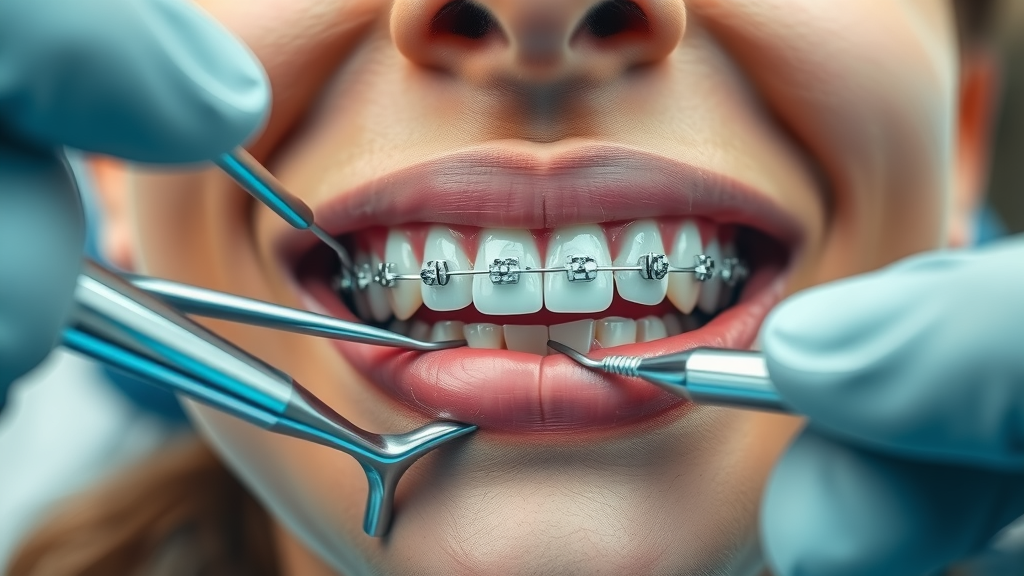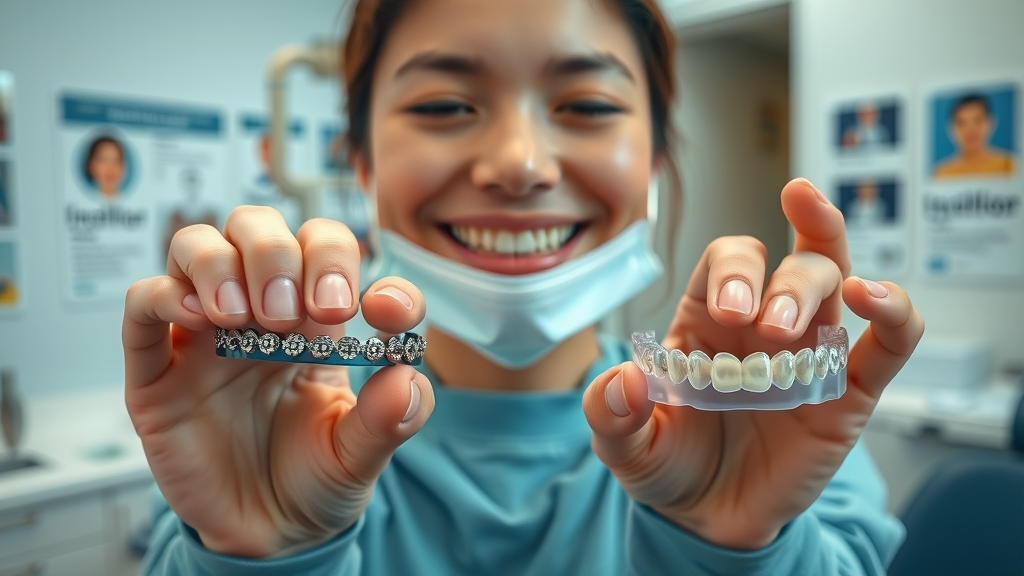Have you ever wondered if you could swap your metal braces for clear Invisalign aligners halfway through your orthodontic treatment? What if you could enjoy a more comfortable and discreet solution without starting over? This comprehensive guide reveals what you need to know about making the switch—from timing and costs to oral hygiene and insurance—helping you decide if transforming your orthodontic journey is right for you.
Opening Question: Is Switching from Braces to Aligners Mid-Treatment Right for You?
Choosing the best orthodontic treatment isn’t just about how you start—it’s also about adapting as your needs, lifestyle, or smile goals change. Many patients wearing braces ask: Can I switch from braces to aligners mid-treatment? The answer isn’t simple, because your ability to switch — and the results you get — depends on several factors, including your specific alignment issues, stage of treatment, and your orthodontist’s recommendation. However, for many, transitioning from metal braces to clear aligners like Invisalign could offer greater comfort, fewer lifestyle restrictions, improved oral hygiene, and nearly invisible treatment. Understanding your options now can put you on the path to a more confident, healthier smile sooner than you think.
Challenging the Norm: Rethinking Braces to Invisalign Transitions
Traditionally, most people believed that once metal braces went on, you had to finish treatment before exploring other options. However, advancements in orthodontic technology—and wider experience with aligners—have opened doors for mid-treatment switching. Today, orthodontic specialists can reassess your braces treatment progress and, if you’re an eligible candidate, help you switch from braces to Invisalign or another clear aligner system partway through your orthodontic journey. This challenging of the norm means more flexible treatment plans, but it’s vital to understand the processes, criteria, and commitments involved in making the change.

What You’ll Learn in This Guide
Key takeaways on: Can I switch from braces to aligners mid-treatment?
Understanding orthodontic treatment intervals
The differences between braces and Invisalign
The factors affecting the switch
Step-by-step guide to talking with your provider
Understanding Traditional Metal Braces in Orthodontic Treatment
How Metal Braces Work in Braces Treatment Plans
Metal braces remain a mainstay in orthodontic treatment for good reason: they are highly effective for correcting a wide range of alignment issues, from minor crowding to complex bite problems. Braces consist of brackets attached to your teeth and connected by wires, which your orthodontist regularly adjusts to gradually move your teeth into the targeted positions. The treatment plan is usually mapped out in stages, and progress is monitored during each visit. Patients sometimes find that wearing braces brings challenges—they can cause discomfort after adjustments, and their visibility is often a concern for teens and adults. Yet, for certain orthodontic cases, metal braces offer reliable results within a predictable treatment time.

Limitations of Metal Braces vs Aligners
Despite their effectiveness, traditional braces come with some drawbacks compared to clear aligners like Invisalign. Brackets and wires can make oral hygiene more challenging, increasing the risk of plaque buildup and cavities if not cleaned meticulously. Many patients find braces restrict their food choices (no sticky or very hard foods), and adjusting to the fixed appliances can cause mouth sores or irritation. In contrast, aligners are removable, allowing for easier brushing, flossing, and eating. Of course, not every orthodontic case is suitable for aligners, and your orthodontist will evaluate if switching from braces to aligners is appropriate for your specific needs.
For those considering a switch, it's important to understand that while aligners offer many advantages, they also have certain limitations—especially when it comes to controlling specific tooth movements. If you're curious about how Invisalign manages complex cases like labial incisor movement, this patient-focused guide on Invisalign’s control of incisor movement provides valuable insights into what aligners can and cannot achieve.
Aligners Explained: How Braces to Invisalign Switching Works
Switch from Braces to Invisalign: Is It Possible Mid-Treatment?
Yes, it is possible to switch from braces to Invisalign or other clear aligners in the middle of treatment—provided your orthodontic case meets certain clinical criteria. After an initial period of teeth movement achieved with braces, many patients are eligible to complete their treatment with aligners, especially if major alignment issues have been corrected. This option appeals to those seeking a less visible, more comfortable, and flexible way to finish their orthodontic journey. A thorough assessment is necessary, as more involved or complex cases may still require finishing with metal braces for optimal results.
"In some cases, switching from braces to aligners mid-treatment can offer more flexibility for patients—if the timing and orthodontic needs are right." — Orthodontic Specialist
Switching From Braces: The Clinical Criteria
Transitioning to aligners is not a one-size-fits-all solution. To switch to Invisalign, your orthodontist will evaluate your current treatment status, review your treatment plan, and perform a thorough examination. Key factors include the degree of movement remaining, the stability of tooth positions, and your ability to comply with aligner wear (most commonly, 22 hours/day). Some limitations may apply—such as for patients with extensive bite corrections or those whose alignment issues are best addressed with traditional braces. Ultimately, only your orthodontist can confirm your eligibility and map out your new course of treatment.
Step-by-Step: How to Switch to Invisalign During Braces Treatment
Assessment of your current orthodontic treatment status
Determining eligibility to switch to Invisalign based on clinical criteria
Customizing your new treatment plan and creating digital scans or impressions
Making the transition with your orthodontic provider’s guidance

The process of switching from braces to aligners is carefully managed. First, your orthodontist will evaluate your teeth’s movement so far. If eligible, they’ll remove your metal braces and take detailed scans or impressions to craft your custom Invisalign aligners. After receiving your aligners, you’ll follow a new treatment plan, wearing each set as instructed (usually one to two weeks per aligner), and attending periodic check-ups for monitoring. If at any stage the aligners are not achieving desired results, your provider may adjust your plan for the best possible outcome.
Treatment Plan Adjustments: What Changes When You Switch from Braces to Aligners Mid-Treatment?
Switching from braces to Invisalign mid-treatment requires a revised approach. The treatment plan may become more flexible, as clear aligners allow for at-home monitoring (in some practices) and reduce the frequency of in-office adjustments compared to braces. Comfort usually increases as patients can remove aligners to eat and clean their teeth. However, compliance becomes essential—if you don’t wear the aligners as prescribed, your treatment time may increase, or results may fall short. Your orthodontist will discuss expected changes, potential additional costs, and how the overall process will help address your remaining alignment issues.
Feature |
Metal Braces |
Invisalign Aligners |
|---|---|---|
Efficacy |
Highly effective for all orthodontic cases, especially complex ones |
Effective for most mild-to-moderate alignment issues |
Visibility |
Noticeable brackets and wires |
Virtually invisible clear plastic trays |
Comfort |
May cause mouth irritation from wires/brackets |
Smooth, no metal, less irritation |
Maintenance |
Requires special cleaning tools; food restrictions apply |
Easier to brush and floss; removable trays |
Typical Treatment Duration |
12-36 months, depending on complexity |
12-18 months for most cases after switch |
Cost Estimates |
$3,000-$7,000 (may vary) |
Additional $1,000-$3,000 to switch mid-treatment |
Impact on Oral Hygiene |
Challenging; risk of plaque build-up |
Improved; easier to maintain with removable aligners |
Factors to Consider Before Switching to Invisalign
Your specific orthodontic issues and alignment needs
The current stage of your braces treatment
Dental insurance coverage and possible additional costs
Your oral hygiene habits and daily routines
Your provider’s expertise in switching from braces
Before deciding to switch from braces, weigh these key considerations and have a transparent discussion with your provider. Every case is unique, and transitioning can mean extra costs, changes in timelines, or new compliance requirements. An experienced orthodontist will provide personalized advice based upon your goals and medical history.
Dental Insurance and Costs: What to Expect When You Switch from Braces to Aligners Mid-Treatment
Insurance Coverage for Switching to Invisalign
Dental insurance coverage for mid-treatment switching varies by plan. Some providers view Invisalign and metal braces as separate treatment options and may only cover one appliance. In cases where coverage is possible, there may be a cap on orthodontic benefits or a limit for switching appliances. Always check with your insurer and request a pre-authorization before making the switch, to avoid surprises and understand your out-of-pocket obligation.
Out-of-Pocket Costs and Financing Options
Additional costs are common when switching appliances, due in part to new records, digital scans, and fabrication of Invisalign aligners. You may be responsible for the cost difference between braces and aligners, which can range from $1,000 to $3,000 or more depending on your case complexity and how much treatment remains. Many orthodontic offices offer financing or installment payment plans, making the transition more financially manageable. Always discuss payment options and get a clear, written estimate before you decide to switch.

Maintaining Oral Hygiene When You Switch from Braces to Invisalign
Always brush and floss before putting your aligners back in
Use recommended oral care products such as antibacterial rinses and soft toothbrushes
Clean your Invisalign aligners daily with mild soap and cool water (not toothpaste, which can scratch them)
Follow a stricter hygiene routine since aligners are removable and must be kept clean to prevent bacteria buildup
Switching to aligners often leads to improved oral hygiene, but requires consistency and discipline
Maintaining oral hygiene is often easier with clear aligners than with braces, but skipping or rushing your cleaning routine can quickly compromise dental health. Following the right habits is crucial for a healthy mouth and a successful treatment outcome—whichever system you use.

Braces and Invisalign: Success Stories and Patient Testimonials
"Switching from metal braces to Invisalign mid-treatment gave me the freedom I needed as an adult professional." — Satisfied Patient
Many patients who have opted to switch from braces to aligners share positive stories about their orthodontic journey. The ability to remove aligners for important events, improved comfort while eating, and increased ease of cleaning their teeth are all common benefits cited by adults and teens alike. However, discipline is key—successful transitions require following your provider’s instructions closely and wearing the Invisalign aligner trays as prescribed.

Common Concerns When Switching from Braces to Aligners Mid-Treatment
Potential initial discomfort as you adapt to a new appliance
Treatment interruptions and adjustments to the new routine
Ensuring compliance—aligners must be worn 22 hours/day
Final outcomes and how switching may affect your smile
Address all your concerns directly with your provider before making the switch. Their expertise can help you anticipate and plan for any challenges unique to combining braces and Invisalign in one treatment plan.
People Also Ask: Can you switch orthodontists in the middle of treatment with Invisalign?
Answer: Yes, but ensure transfer of complete dental records and ongoing communication between providers for continuous orthodontic treatment success.
Switching orthodontists during Invisalign treatment is possible. Be sure your records, digital scans, and treatment timelines are properly transferred to maintain continuity. Ongoing communication helps minimize interruptions in your treatment plan and ensures your new provider understands your goals and previous progress.
People Also Ask: What is the 22 Hour Rule for Invisalign?
Answer: The 22-hour rule refers to the requirement that Invisalign aligners be worn for at least 22 hours a day for effective treatment results.
For Invisalign aligners to do their job, you must wear them nearly all day—removing them only for eating, drinking anything but water, and cleaning your teeth. Falling below 22 hours/day risks setbacks and extended treatment time. Consistency is key to optimal results!
People Also Ask: Can you change orthodontists in the middle of treatment?
Answer: You can change orthodontists during treatment, but continuity of care is vital for maintaining your treatment plan and monitoring outcomes.
If you move, change insurance, or need a different provider for any reason, make sure a full transfer of dental records and treatment data occurs. Keeping your treatment plan on track ensures you’ll reach your final smile goal without unnecessary delays.
People Also Ask: What happens if I move in the middle of Invisalign treatment?
Answer: If you move, contact your orthodontist to coordinate ongoing treatment and arrange for a new provider to receive your records and aligners.
Even in mid-treatment, your new orthodontist can pick up where the last one left off, as long as detailed records—sometimes including the digital Invisalign aligner file—are transferred. This helps maintain progress and minimizes disruptions.
Key Takeaways: Switching from Braces to Aligners Mid-Treatment
Switching is possible but requires clinical approval and depends on your individual orthodontic needs
Expect impacts on the treatment plan, potential increases in cost, and new compliance requirements
Prioritize oral hygiene and strict aligner use for best results after the switch
Frequently Asked Questions: Braces to Invisalign and Mid-Treatment Switching
Who is eligible to switch from braces to aligners mid-treatment?
Patients in the mid-to-late phase of braces treatment, who have completed major tooth movements and have only mild-to-moderate corrections left, are often eligible. Your orthodontist will make the final call.How long does the transition process take?
The process takes about 2-4 weeks, allowing time for braces removal, digital scans, aligner fabrication, and delivery.Are there any side effects?
Some users report temporary tooth soreness or noticeable pressure when switching from braces to aligners. This typically lasts a few days.How do the effectiveness and outcomes compare?
For many mild cases, clear aligners can be just as effective as braces. However, severe bite or alignment issues still respond best to metal braces or a hybrid treatment plan.
Conclusion: Making an Informed Decision on Switching from Braces to Aligners Mid-Treatment
Summary of options and encouragement to consult your orthodontic provider for a personalized treatment plan.
Switching from braces to aligners mid-treatment is an exciting possibility, but it’s not for everyone. Always consult your orthodontist to explore your options and build a treatment plan tailored to your smile.
Watch an orthodontic expert discuss the process, criteria, and clinical concerns in the braces to aligner switch—featuring real-world visuals and patient consultations to help you decide your next step.
See the transition in action—how a patient moves from metal braces to Invisalign aligners in easy-to-follow steps demonstrated by dental professionals.
Hear firsthand from a patient about switching, their challenges and wins, and why the decision worked out for their lifestyle and smile goals.
Your Next Step: Get Trusted Advice and Stay Connected
Your smile is worth it — and staying informed is the first step. Join hundreds of locals already following Grand Strand Smile Spotlight for updates, advice, and trusted care insights.
If you’re eager to take the next step in your orthodontic journey, remember that every smile transformation is unique. For a deeper dive into the full range of orthodontic solutions, including expert tips and local resources, explore our comprehensive orthodontist directory and resource center. Whether you’re weighing your options or ready to consult a specialist, you’ll find guidance to help you make confident, informed decisions about your dental health. Unlock more advanced strategies and discover how the right provider can personalize your treatment for the best possible results.
Switching from traditional braces to clear aligners mid-treatment is a possibility for many patients, but it depends on individual circumstances. According to Thrive Dental and Orthodontics, suitable candidates typically have mild to moderate alignment issues, have made significant progress with braces, and are committed to wearing aligners for 20–22 hours per day. (thrivedentist.com)
The transition process involves several steps:
Consultation and Evaluation: Your orthodontist will assess your current alignment and determine if aligners can effectively complete your treatment. (idortho.com)
Braces Removal: If deemed suitable, your braces will be carefully removed.
Impressions or Scans: Digital scans or impressions of your teeth will be taken to create custom aligners.
Aligner Fitting: Once your aligners are ready, you’ll begin wearing them as prescribed, typically for 20–22 hours daily.
It’s important to note that not all cases are ideal for switching. Severe misalignments or complex bite issues may still require the precision of traditional braces. Additionally, transitioning may involve additional costs, including new scans, aligner fabrication, and potential adjustments to your treatment plan. (brushhollowortho.com)
Before making a decision, consult with your orthodontist to evaluate your specific situation and determine the best course of action for achieving your desired smile.
 Add Row
Add Row  Add
Add 




Write A Comment